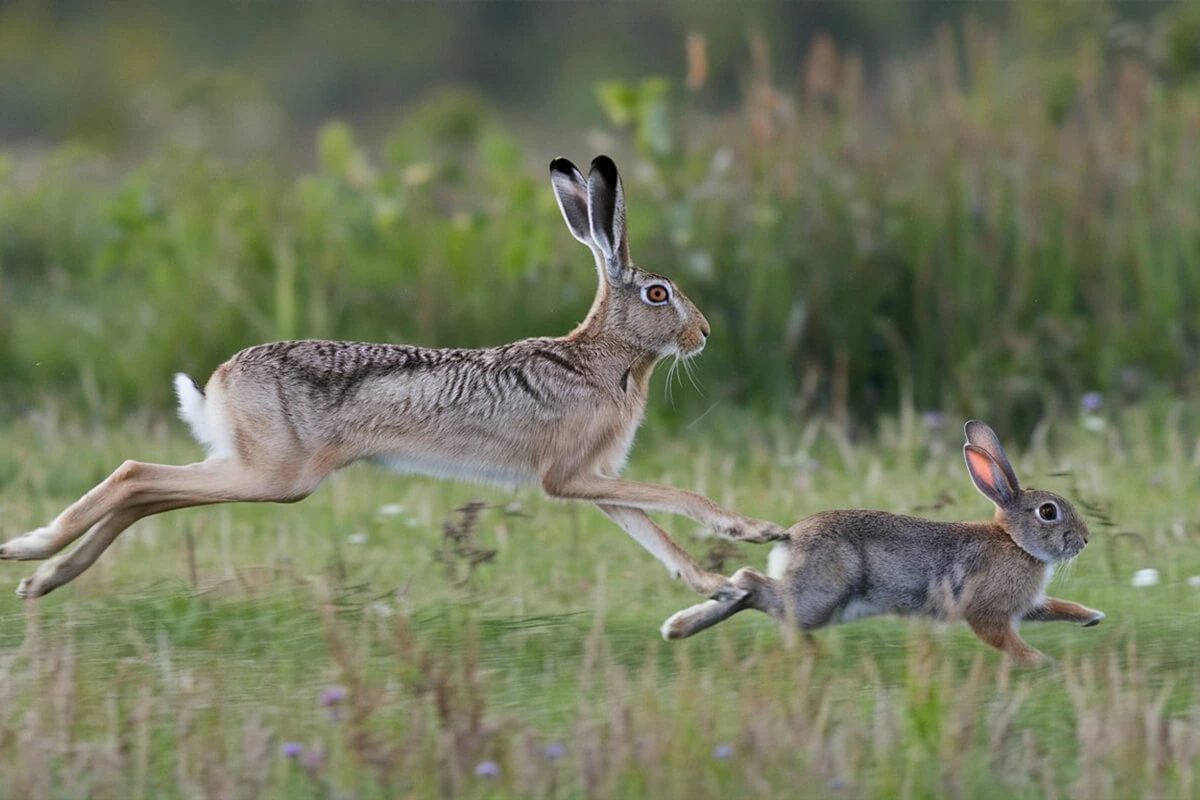Hares and rabbits may look similar, but when it comes to speed, they have some major differences. Hare vs rabbit speed is a fascinating topic because both animals rely on their agility to escape predators, yet hares have a clear advantage in raw speed. Understanding how fast they can run and why hares are faster than rabbits gives insight into their survival strategies and physical adaptations.
Speed plays a critical role in the lives of both hares and rabbits. Whether they are fleeing from a hungry fox or dodging a swooping hawk, their ability to outrun danger often determines whether they survive. Hare vs rabbit speed varies due to differences in body structure, muscle strength, and movement patterns. Hares, built for open landscapes, sprint at incredible speeds, while rabbits, better suited for quick dashes and evasive maneuvers, rely on agility and hiding tactics.
In this post, we’ll explore seven fascinating facts about hare vs rabbit speed. You’ll learn how fast each can run, why hares have the advantage, and whether a rabbit can ever outrun a predator. By the end, you’ll have a clear understanding of what makes these animals such incredible runners in the wild.
How Fast Can a Hare Run Compared to a Rabbit?
Speed plays a critical role in the survival of both hares and rabbits, but hares generally have a significant advantage. Their long, powerful legs and lightweight bodies allow them to reach high speeds in open environments. Rabbits, on the other hand, rely more on quick bursts of speed and agility to escape predators. Let’s break down the differences in their speed capabilities.
Hare Speed vs Rabbit Speed
Hares run much faster than rabbits due to their longer legs and stronger muscles. On average, a hare can reach speeds of 35 to 45 mph (56 to 72 km/h), while a rabbit typically runs at 25 to 30 mph (40 to 48 km/h). This speed difference allows hares to cover long distances quickly, making it easier for them to escape predators in open fields.
Hares also have a unique sprinting style that helps them maintain their high speeds. They rely on powerful leaps and long strides, which allow them to accelerate quickly and sustain their pace over longer distances. Rabbits, in contrast, use short, rapid hops to navigate their surroundings. Their speed is useful for dodging and weaving through dense vegetation, but they struggle to maintain high speeds for long periods.
Fastest Hare Species
Not all hares run at the same speed. Some species have evolved to be exceptionally fast due to their environment. The jackrabbit, which is actually a type of hare, holds the title for one of the fastest hares in the world. The black-tailed jackrabbit (Lepus californicus) can reach speeds of up to 45 mph (72 km/h) in short bursts, making it one of the fastest land mammals for its size.
Other hare species, such as the European hare (Lepus europaeus), can reach speeds of up to 43 mph (70 km/h). Their powerful hind legs help them make quick, long jumps, allowing them to cover large distances with minimal effort. These speed adaptations make hares well-suited for open landscapes where running is their primary defense against predators.
Rabbit Top Speed
While rabbits are not as fast as hares, they are still incredibly quick for their size. The cottontail rabbit (Sylvilagus spp.), one of the most common rabbit species, has a top speed of 30 mph (48 km/h). Unlike hares, rabbits rely more on quick acceleration and sharp turns to escape threats.
Rabbits excel at navigating dense environments like forests and grasslands, where they can use their agility to evade predators. Instead of relying solely on speed, they take advantage of their ability to make rapid, unpredictable movements. This strategy helps them avoid capture, even if they can’t outrun their predators in a straight-line race.
By understanding the speed differences between hares and rabbits, it’s clear why hares have a significant advantage in open terrain, while rabbits rely on agility and hiding tactics to survive.
Why Are Hares Faster Than Rabbits?
Hares and rabbits may look alike, but their speed differences come down to their body structure, leg strength, and movement style. Hares evolved for long-distance sprinting, while rabbits rely on short bursts of speed and agility. These physical differences determine how each animal escapes predators and moves through their environment.
Body Structure Differences
Hares have long, lean bodies built for speed, while rabbits have compact, stocky frames designed for quick, explosive movements. The most noticeable difference is in their leg length and muscle composition. Hares have much longer legs in proportion to their bodies, giving them a greater stride length and allowing them to cover more ground with each step.
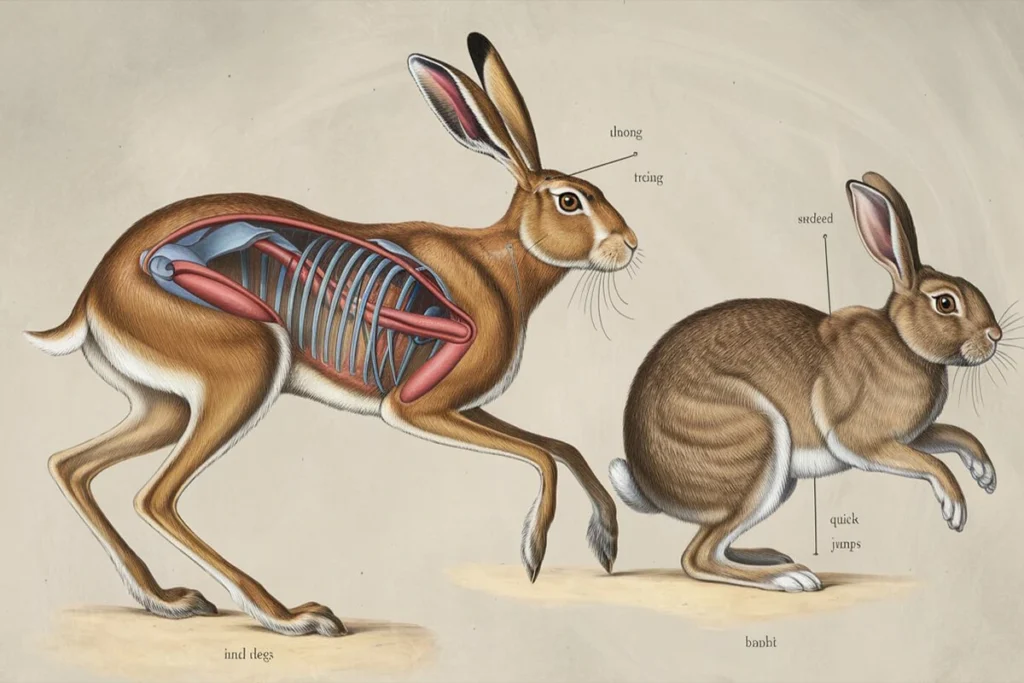
Another key difference is in their skeletal structure. Hares have lighter, more elongated bones that reduce body weight and allow for faster acceleration. Their longer ears also help with thermoregulation, keeping them cool while running at high speeds. In contrast, rabbits have a denser bone structure, which helps them burrow and stay hidden rather than rely on outrunning predators.
Additionally, hares have larger hearts and lungs, which improve oxygen intake and endurance. These adaptations allow hares to sustain their high speeds for longer periods, while rabbits can only sprint for short distances before tiring.
Hind Leg Strength
The strength of their hind legs plays a major role in why hares are faster than rabbits. Hares have incredibly powerful and elongated hind legs that provide explosive force when they push off the ground. Their leg muscles contain a higher proportion of fast-twitch muscle fibers, which generate bursts of speed allow them to sprint at up to 45 mph (72 km/h).
Rabbits also have strong hind legs, but they are built for agility rather than top speed. Their muscles contain more slow-twitch fibers, which help with endurance and quick changes in direction. Instead of outrunning predators in a straight line, rabbits use their legs to make sudden, unpredictable movements that help them escape.
One of the best examples of hare leg power is the jackrabbit, which can jump up to 10 feet (3 meters) in a single bound. This ability helps hares evade predators in open terrain by covering large distances quickly. In contrast, rabbits rely on shorter but quicker jumps to dodge obstacles and dive into burrows.
Sprinting vs. Hopping
Hares rely on sprinting, while rabbits use hopping as their primary mode of movement. Sprinting gives hares an advantage in open landscapes, where they can use their long strides to reach high speeds and escape danger. Their zigzag running pattern helps them evade predators by making it difficult for hunters to predict their next move.
Rabbits, on the other hand, move with a rapid hopping motion that allows them to quickly maneuver through dense vegetation. Their shorter legs make them less efficient at sprinting, but their hopping ability helps them navigate tight spaces and escape into burrows. Rabbits also use their strong hind legs to push off the ground quickly, allowing them to accelerate instantly when threatened.
While hares can maintain their speed for longer distances, rabbits excel at quick acceleration and sharp turns. This difference in movement style shows how each animal evolved to survive in different environments—hares in open fields and grasslands, and rabbits in forests, bushes, and underground burrows.
By comparing body structure, hind leg strength, and movement style, it’s clear why hares are faster than rabbits. Their longer legs, stronger muscles, and sprinting ability give them an edge in speed, while rabbits rely more on agility and evasive maneuvers to avoid predators.
Speed Adaptations in Hares and Rabbits
Hares and rabbits both rely on speed to survive, but they use different techniques to evade predators. Their adaptations go beyond just how fast they can run—they also depend on their ability to change direction, use the environment to their advantage, and react quickly to threats. These strategies determine how successful they are at escaping danger.
Predator Evasion
Both hares and rabbits face constant threats from predators like foxes, coyotes, hawks, and eagles. Their speed plays a critical role in survival, but how they use it depends on their physical abilities and surroundings.
- Hares depend on outrunning predators. Their high-speed sprints allow them to put distance between themselves and a pursuing predator. Instead of finding shelter, they rely on their speed to escape into open landscapes where they have plenty of room to maneuver.
- Rabbits use a combination of speed and hiding. While they can sprint in short bursts, they usually try to reach cover as quickly as possible. Their small, compact bodies make it easier for them to slip into burrows, thick bushes, or tall grass to avoid being caught.
Hares have a better chance of escaping predators in a long chase, while rabbits have a greater advantage in environments where they can use obstacles to block a predator’s path.
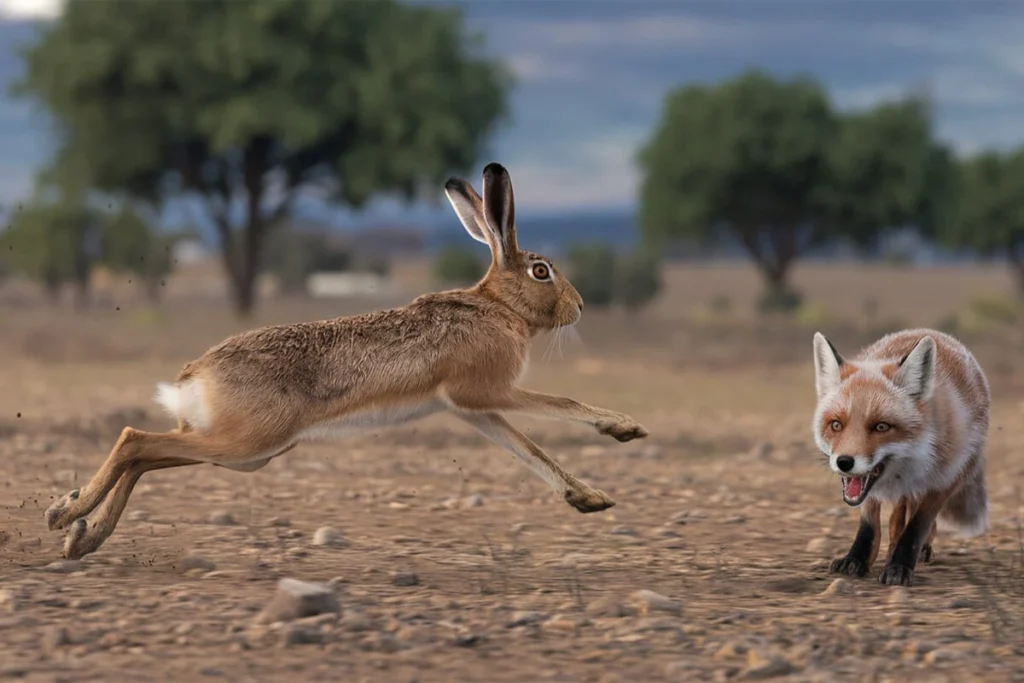
Zigzag Running
Speed alone doesn’t always help an animal escape—the ability to change direction quickly can mean the difference between life and death. Both hares and rabbits use zigzag running patterns to confuse predators, but hares are particularly skilled at this technique.
- Hares use high-speed zigzags to throw off predators chasing them at full speed. Their long, strong legs allow them to shift direction suddenly while maintaining momentum. This movement pattern makes it difficult for a predator to predict their next move and react in time.
- Rabbits perform quick, unpredictable hops and turns. Instead of running long distances, they rely on rapid direction changes to dodge predators in dense vegetation. A rabbit will often dart in one direction, suddenly leap sideways, and then dash into a burrow before a predator can react.
Zigzag running works particularly well against fast predators like foxes and birds of prey, which rely on a straight-line chase to catch their target. By constantly changing direction, hares and rabbits make it harder for their enemies to stay locked onto them.
Environmental Adaptations
The environment plays a huge role in how hares and rabbits use speed to survive. Their surroundings influence how they evade predators and what kind of movement works best in their habitat.
- Hares thrive in open landscapes like fields, deserts, and grasslands. Their long legs and high speeds make them well-suited for wide, flat terrain where they can sprint without obstacles slowing them down. Since hares don’t dig burrows like rabbits, they rely entirely on their running ability to escape danger.
- Rabbits prefer dense forests, shrubs, and grassy areas. Their shorter legs and smaller bodies allow them to move easily through thick vegetation. Instead of sprinting long distances, they rely on quick bursts of speed to reach the nearest shelter. Their ability to navigate tight spaces helps them escape predators that are too large to follow them into burrows or tangled bushes.
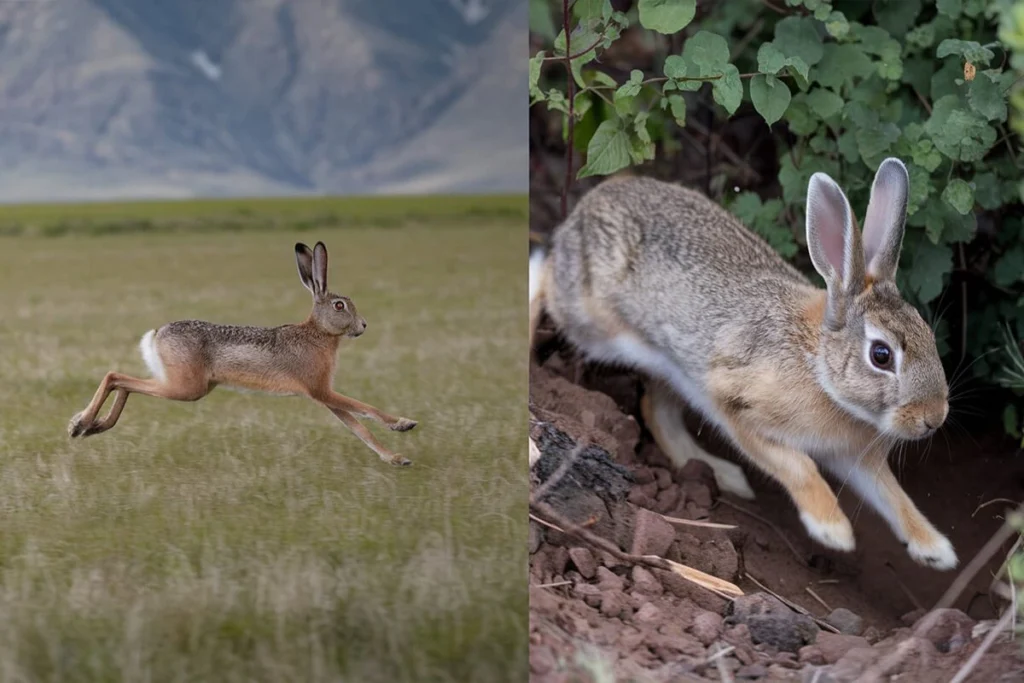
Hares evolved for speed and endurance, while rabbits developed agility and maneuverability. These adaptations ensure both animals can survive in their respective habitats, using their unique movement strategies to evade threats.
By understanding how predator evasion, zigzag running, and environmental factors shape their survival tactics, it becomes clear why hares rely on speed, while rabbits use agility and cover to stay alive.
Can a Rabbit Outrun a Predator?
Rabbits and hares constantly face threats from predators that rely on speed, stealth, and agility to catch them. Their survival depends on how well they can escape, whether by sprinting, making sharp turns, or seeking shelter. While hares have the advantage in straight-line speed, rabbits use other tactics to avoid becoming prey.
Common Predators of Rabbits and Hares
Many animals hunt rabbits and hares, each using different techniques to catch them. Some predators rely on raw speed, while others use ambush tactics or aerial attacks.
- Mammalian Predators: Foxes, coyotes, bobcats, and wildcats are among the most dangerous threats. These predators use bursts of speed to chase down their prey, and some, like foxes, also use intelligence and strategy to catch rabbits and hares.
- Birds of Prey: Hawks, eagles, and owls pose a serious risk, especially for younger or smaller rabbits. These birds strike from above, using their sharp vision to spot a rabbit in the open before swooping down at high speeds.
- Reptilian Hunters: Some snakes, especially large constrictors, ambush rabbits and hares, striking quickly before the prey can escape.
- Humans and Domesticated Predators: People hunt hares and rabbits for sport, food, and fur, while domestic animals like dogs and cats often chase and kill them, even when not hungry.
Predators determine how hares and rabbits evolve their escape tactics. Since hares usually deal with fast, ground-based hunters, they rely on speed. Rabbits face a mix of ground and aerial threats, so they combine agility with the ability to hide.
Rabbit Running Ability
Rabbits may not be as fast as hares, but they can still reach impressive speeds. Most rabbit species run at 25 to 30 mph (40 to 48 km/h), which is fast enough to escape many predators if they react quickly. Their greatest strength isn’t top speed—it’s acceleration and maneuverability.
- Quick bursts of speed: Rabbits can reach top speed almost instantly, helping them escape ambushes.
- Sharp turns and unpredictable movements: Instead of running in a straight line, rabbits dart back and forth, making it hard for predators to predict where they’ll go next.
- Powerful hind legs for explosive jumps: Their strong legs allow them to leap great distances, which helps them clear obstacles and gain extra ground in an escape.
Unlike hares, rabbits can’t sustain high speeds for long distances. If they don’t reach shelter quickly, they risk exhaustion or capture. Their bodies are designed for quick reactions rather than endurance.
Survival Strategies
Rabbits and hares survive by using different escape techniques. Since rabbits can’t rely on outrunning all predators, they focus on finding cover.
- Burrowing for safety: Rabbits dig burrows underground, giving them a place to hide when danger approaches. The entrance to a burrow is usually close to where they feed, allowing for a quick escape.
- Using dense vegetation: If a burrow isn’t nearby, a rabbit will dive into bushes, tall grass, or under logs to break the predator’s line of sight.
- Freezing in place: Instead of running immediately, a rabbit sometimes stays still to blend in with its surroundings. If a predator doesn’t see movement, it may pass by without noticing the rabbit.
- Group behavior: Some rabbits, like cottontails, live in areas with other rabbits nearby. When one spots danger, it alerts the others, allowing the entire group to escape in different directions.
Hares, lacking burrows, must rely entirely on speed and agility. They sprint to safety, using zigzag running to make pursuit difficult. Their longer legs and leaner bodies allow them to cover vast distances quickly, ensuring they stay ahead of their predators.
By combining speed, agility, and hiding techniques, both rabbits and hares maximize their chances of survival. While hares depend on their ability to outrun threats, rabbits take advantage of their environment and quick reflexes to evade capture.
Final Speed Comparison – Which is Faster?
Hares and rabbits may belong to the same family, but their speed and movement styles give them very different advantages. While hares dominate in terms of raw speed and endurance, rabbits excel at agility and evasion tactics. Their adaptations determine when each animal has the upper hand in an escape situation.
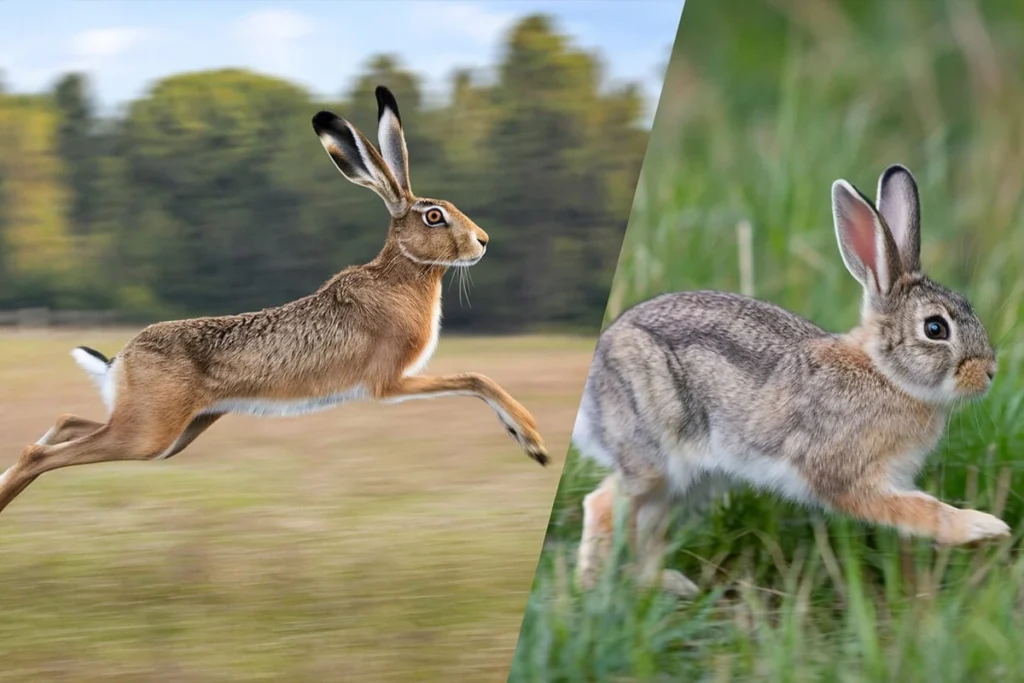
Summary of Key Speed Differences
Hares vs rabbit speed varies significantly in terms of top speed, acceleration, endurance, and movement style. These differences determine how each species reacts to predators and how they survive in their natural habitats.
- Hares are significantly faster than rabbits. The average hare can reach speeds of 35 to 45 mph (56 to 72 km/h), while rabbits run at 25 to 30 mph (40 to 48 km/h). This difference in speed allows hares to outrun predators over long distances.
- Rabbits accelerate faster but tire quickly. Although rabbits don’t match hares in top speed, they can reach their maximum velocity almost instantly. This quick acceleration gives them an initial advantage in a chase, but they fatigue quickly and must find shelter fast.
- Hares have longer strides and sustain speed. Their long, powerful hind legs help them cover more ground with each step, making them highly efficient sprinters in open landscapes.
- Rabbits rely on short bursts and evasive tactics. Instead of sprinting long distances, rabbits use quick, unpredictable movements, sharp turns, and natural obstacles to escape predators.
These key differences explain why hares thrive in open fields and grasslands, where their high-speed running helps them survive. In contrast, rabbits do better in forests, shrubs, and burrowed environments, where their agility and ability to hide give them a survival advantage. Hare vs rabbit speed isn’t just about how fast they run—it’s about how they use their speed effectively in the wild.
When Hares Have the Advantage
Hares perform best when they have enough space to use their speed to escape. Their long legs, powerful muscles, and endurance make them the superior sprinters in certain conditions.
- Open fields and grasslands: Hares evolved to survive in wide, open spaces where their speed is their primary defense. In these environments, they have no obstacles blocking their path, allowing them to reach full speed quickly.
- Long-distance chases: If a predator spots a hare from a distance, the hare has enough time to accelerate and outrun the threat. Since hares don’t rely on burrows, they must rely on their ability to stay ahead of predators.
- Against fast but less agile predators: Some predators, like wolves or foxes, may be quick, but they struggle with the sharp turns that hares make while running at high speeds. The hare’s ability to zigzag helps it evade capture.
- During daylight hours: Since hares don’t rely on burrows for safety, they are more active during the day when they can use their vision and speed to detect and escape predators early.
In any situation where running in a straight line is possible, hares hold the clear advantage over rabbits in terms of speed and endurance.
When Rabbits Can Still Escape
Despite being slower than hares, rabbits have survival strategies that allow them to escape predators in many situations. Hare vs rabbit speed may show hares as the faster runners, but rabbits compensate with their ability to react quickly, find cover, and maneuver through tight spaces to evade danger even without top speed.
- Dense vegetation and forests: Rabbits excel in environments where obstacles like trees, bushes, and rocks slow down their predators. Since rabbits don’t need a long, open space to escape, they use their surroundings to their advantage, weaving through dense foliage where larger predators struggle to follow.
- Burrow proximity: Unlike hares, rabbits rely on a safe retreat underground. When a predator approaches, a rabbit only needs to sprint a short distance to reach its burrow, where most predators cannot follow. This gives rabbits a significant survival advantage over hares, which must rely solely on running.
- Against large or less maneuverable predators: Some predators, like larger dogs or birds of prey, have difficulty chasing rabbits through dense undergrowth. Rabbits take advantage of their small size and quick directional changes, making it difficult for predators to catch them.
- During nighttime or low-visibility conditions: Since rabbits often stay active at dusk and night, they use the cover of darkness to move unnoticed and avoid predators before a chase even begins. This stealth-based survival tactic further reduces their need for raw speed.
While hares dominate in hare vs rabbit speed, rabbits have evolved their own strengths to evade predators successfully. Their quick reflexes, ability to change direction instantly, and natural hiding instincts make them just as effective at survival in their environments. By understanding these speed differences, it’s clear that hares and rabbits rely on distinct strategies—hares use speed and endurance to escape in open landscapes, while rabbits depend on agility, quick escapes, and cover to stay alive.in different situations, proving that speed isn’t the only factor in predator evasion—it’s how they use it that matters.
Conclusion
When comparing hare vs rabbit speed, it’s clear that both animals have evolved unique adaptations that help them survive in different environments. Hares, with their long legs and powerful muscles, can reach speeds of 35 to 45 mph (56 to 72 km/h), allowing them to outrun predators over long distances. They rely on pure speed, endurance, and zigzag running to escape threats in open landscapes.
Rabbits, on the other hand, may be slower, reaching 25 to 30 mph (40 to 48 km/h), but their acceleration and agility give them an advantage in tight spaces. Instead of relying on endurance, rabbits use quick bursts of speed, sharp turns, and burrows to evade predators. Their ability to maneuver through dense vegetation and dive into hiding spots makes them just as effective at escaping threats as hares.
The speed comparison of hares and rabbits highlights how these animals have adapted to their surroundings. Hares dominate in open fields and long chases, while rabbits excel in forests and obstacle-filled environments. While hares win in raw speed, rabbits use strategy and quick reflexes to survive.
Ultimately, hare vs rabbit speed isn’t just about how fast they can run—it’s about how they use their speed to stay alive. Whether sprinting across grasslands or darting into a burrow, each species has perfected its survival strategy in the wild.
You Have A Fluffy Rabbit and look for a Nice and Unique Name for it? Find the Best From Our 100 names Guide
Find Out More about Pets and Different breeds From HERE!
Discover the Best stuff for your Pet On Pet MD Official
